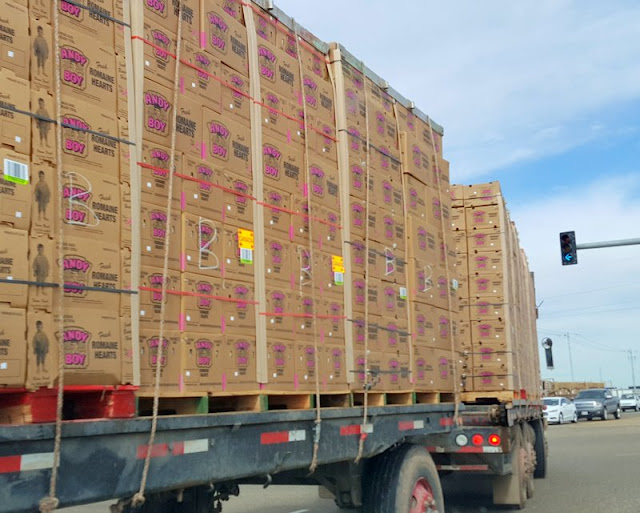 We have been living in the desert for a few weeks, and we are used to the barren fields of sand and cacti now. We are also used to the dips in the roads with signs warning not to enter when the roads are flooded. It's a little hard to imagine that much water around here! Those steep dips look like a little wrinkle in the road when you try taking a picture, but they feel like part of a roller coaster ride when you cross them at 65 mph in a motor home.
We have been living in the desert for a few weeks, and we are used to the barren fields of sand and cacti now. We are also used to the dips in the roads with signs warning not to enter when the roads are flooded. It's a little hard to imagine that much water around here! Those steep dips look like a little wrinkle in the road when you try taking a picture, but they feel like part of a roller coaster ride when you cross them at 65 mph in a motor home.There has been enough rain lately that we see a hint of green beside the road as we made the drive south from Quartzsite, AZ to our next destination at Yuma, AZ.
After so much brown desert, we are pretty excited to see that the closer we get to Yuma, the more fields of green we see! That would include citrus trees that have been trimmed into curious-looking tree cubes.
We learned that Yuma is the "winter vegetable capitol of the world." As we drive the country roads, we are surrounded by fields of those veggies.
February is a major vegetable harvest month, and we see large groups of farm laborers in the field. They show up in individual cars, or some are transported by big white buses to the field. Those big buses also tow a trailer of port-a-potties to the field with them.
We see some machinery that helps with the harvesting process. Mostly it provides a platform for boxing the vegetables. The picking is done piece by piece and by hand. It looks like a back-breaking job to bend to the ground to cut off each head of cabbage, or each stalk of broccoli, or each head of cauliflower, or each bunch of celery, or each . . . well you get the idea.
We could sit and watch this process for hours. That must mean we are easily entertained. It's also because we have found a road-side factory tour on the farm.
After seeing so many fields of vegetables, Denisa was excited about buying these fresh veggies. But this produce is going straight onto 18-wheelers to packaging plants that transport them all over the United States. We heard that 3,000 trucks stacked high with fresh produce leave Yuma every day.
Those trucks are headed for processing plants with names like Dole and Green Giant. So the only option for fresh vegetables in the winter vegetable capitol of the world is to go to the farmer's market or the grocery store.
Yuma county provides 90% of the leafy vegetables eaten in this country from November to March. Check the lettuce in your refrigerator, because it was probably grown near us.
We haven't seen any spinach being harvested, but the fields of it are a deep beautiful green right now. If that was a crayon, it's color could be "spinach green."
They grow butter lettuce, iceberg, romaine, and other types of greens that we don't even recognize as we zip down the highway. The fields growing burgundy lettuce are really pretty, and a nice salad contrast against the bright green lettuce.
Actually, we aren't always zipping on the highway. We love driving through the country-side, where we can see the crops at slow speed.
Some of those roads are just dirt paths between the fields, and we've had to turn around more than once when we came to an impassible section.
All this green and bountiful food is compliments of water diverted from the Colorado River. Yuma gets around three inches of rain per year, so these crops wouldn't grow without the water that arrives via canals throughout the valley.
Owning water rights is important to land holders. It is interesting to see a cabbage field on one side of the road, and barren desert on the other side of the road. The difference between the two are the water rights. Out of that water comes beautiful heads of cabbage, ready to be picked.
Speaking of water, we are camped about 100 yards from that Colorado River. We chose Hidden Cove RV park for multiple reasons. We liked the location close to the river, and close to the West Wetlands Park.
We can ride our bikes or run to the park, as it is less than a quarter-mile away. There are biking and hiking trails there, as well as gardens, playgrounds, pond, etc. We saw that there were several century plants at the entry that are sending up large stalks to support their once-in-a-lifetime blooms.
The other reason we chose Hidden Cove was its acceptance of the Passport America rate this time of year. Among the 15 passport campgrounds listed in Yuma, most do not honor the half-price rate in January through March. We actually used Hidden Cove's very affordable weekly rate, that got even better when Denisa spotted a 50 dollar coupon for first-time visitors.
We've found that Yuma has some good bike trails, and we've ridden all over town. From the motor home's camp site we can ride all the way to the East Wetlands Park and beyond. We rode under the new Interstate 8 freeway, and can see ahead of us the old "Ocean to Ocean" bridge.
This steel structure was built in 1915, and was the final link to make a driveable passage from the Atlantic to the Pacific via Highway 80. That's the reason it's called the Ocean to Ocean bridge. During the 1930's, carloads of Oklahomans used this bridge to finish their journey west to start a new life away from the depression era drought in their home state. Across the bridge was the magical state of California with promised prosperity. But too many Okies were flooding into the state, and the Los Angeles Chief of Police sent officers to this bridge to screen the Okies and Arkies. They had to prove they had a job waiting for them, or a minimum of $50 in cash before they were allowed to cross the bridge in to California. Many of those that were turned back at this bridge stayed in Yuma, Arizona, and a large neighborhood nicknamed "Okie Town" sprang up in downtown. That was an interesting story for a couple of wandering Okies like us.
We're learning about agriculture and history in our new home. People that have lived here their entire lives are called "totally Yuman." We've also seen signs about keeping parks clean "for the good of Yuman-kind." We plan to be a little more Yuman by the end of our 9-day stay.































0 Response to "Living in the Winter Vegetable Capitol of the World"
Post a Comment